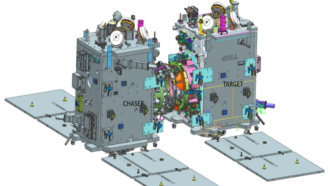![A representative image of a galaxy, M82 pictured here. [Image Credits: NASA, ESA, and The Hubble Heritage Team (STScI/AURA) / Public domain] AstroSat discovers tell-tale signs of cosmic evolution from a young, dynamic galaxy](/sites/researchmatters/files/styles/large_800w_scale/public/galaxy_24aug.jpg?itok=E0PDK1GQ)
A representative image of a galaxy, M82 pictured here. [Image Credits: NASA, ESA, and The Hubble Heritage Team (STScI/AURA) / Public domain]
The age of the Universe is more than 13.7 billion years, and it has evolved a lot since its birth. In the first hundred million years, it was a dull place, containing only hydrogen gas. There were no stars or galaxies. This era is known as the ‘Cosmic Dark Age’. But soon, the first clumps of stars and galaxies started forming, and these stars did what they do best— emit electromagnetic radiation. The photons thus emitted then ionized the ambient hydrogen gas, and today, most of the matter spread between stars and galaxies is ionized hydrogen. The phase between the Cosmic Dark Age and the present-day Universe teeming with stars and galaxies is what astronomers call the ‘reionization phase’.
Many questions regarding the reionization phase remain unanswered. For example, astronomers still do not know when exactly it started or ended, or how it influenced the formations of the earliest galaxies. It is only through a study of the most distant galaxies that astronomers can shed light into these questions. However, the further a galaxy is, the fainter and hence more difficult it is to observe it. In a recent study, a group of astronomers studied a galaxy not too distant from the Earth, using data from AstroSat, India’s first indigenous satellite dedicated to astronomy.

Timeline of the Universe [Image Credits: NASA/WMAP Science Team / Public domain]
The study, published in the journal Nature Astronomy, was led by Professor Kanak Saha from the Indian University Centre for Astronomy & Astrophysics (IUCAA), Pune. It included other astronomers from Tezpur University in Assam, and universities in Switzerland, the USA, Japan, France, and The Netherlands. It was funded in part by the Indo-French Centre for the Promotion of Advanced Research (IFCPAR/CEFIPRA).
AstroSat was launched by the Indian Space Research Organisation, or ISRO, on the 28th of September, 2015. One of the telescopes inside this space-based observatory is the Ultraviolet Imaging Telescope, or UVIT, which specialises in collecting photons with wavelengths in the ultraviolet part of the electromagnetic spectrum. The astronomers used data from the UVIT to study galaxies that could be emitting radiation in these wavelengths.
“Massive, young stars are short-lived, and they emit predominantly in the ultraviolet part of the spectrum,” explains Professor Saha, the lead author of the study.
Earlier observations of these galaxies have been conducted by other telescopes, like NASA’s space-based observatory Swift, which has a dedicated ultraviolet telescope. However, the ionizing radiation from the galaxies have wavelengths much shorter than what these telescopes can detect.
With the UVIT, the astronomers could detect photons of such shorter wavelengths, called the extreme ultraviolet or EUV wavelengths. These photons are the ionizing radiation from the youngest stars in the galaxies. The researchers focussed on a galaxy located about 9.3 billion light-years from the Earth, looking into the past. That is, light from this galaxy has taken about 9.3 billion years to reach us. When they studied its image, they detected EUV radiation from it as they had expected. Past ventures have not found EUV radiation from any galaxy within 4 to 11 billions light-years from the Earth.
“It is the first example of a galaxy leaking extreme ultraviolet photons in that distance,” asserts Professor Saha.
Although a dozen such galaxies have been detected, they are closer to the Earth at a distance less than 4 billion light-years.
By a careful study of the galaxy’s neighbourhood, the researchers ruled out any possible noise of the EUV radiation induced by other neighbouring galaxies. Then they studied in detail its spectrum, that is how the emitted radiation varies with its wavelength. From this, they estimated various properties of the galaxy, including how fast the stars are born inside it, its age, and how fast it is ionising the hydrogen in its surroundings.
The astronomers found that the galaxy consists of many very hot young stars. These stars are massive and have shorter life spans compared to stars like our Sun. They found that the galaxy is relatively young compared to astronomical standards, only about 0.1 billion years in age. Its mass is also less compared to galaxies like the Milky Way, which is a thousand times heavier. They evaluated that it leaks at least 20% of its photons to the surrounding hydrogen gas. These are tell-tale signs of reionization.
The team also found that the galaxy has a clumpy structure, which has not been detected in earlier galaxies.
“This opens up another list of properties observable for galaxies,” shares Prof Saha.
This property, coupled with the low mass, makes it leak many photons in the EUV wavelength range suited for AstroSat’s observations. The distance range probed in the study is uniquely suited for potential discoveries by AstroSat. The researchers think more galaxies are waiting to be detected in the data already collected by UVIT.
Currently, work is in full swing to find them.
“I have already created an image in another direction and identified a few galaxies in this image. Soon, we will have many more,” signs off Professor Saha.
This article has been run past the researchers, whose work is covered, to ensure accuracy.






